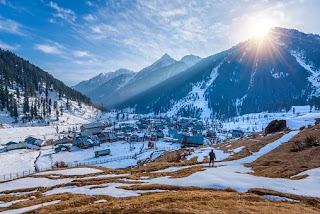. 1.Dal Lake
History:
Dal Lake in Srinagar holds a rich historical legacy dating back to the Mughal era. It was originally a smaller, deeper lake but has evolved over centuries due to silting. The Mughal Gardens surrounding the lake, such as Shalimar Bagh and Nishat Bagh, were built during this period, adding to its cultural significance. **
. Why Famous:
Dal Lake is famous for its scenic beauty and unique ecosystem of houseboats and floating gardens. It offers visitors a tranquil experience amidst serene waters and panoramic views of the surrounding mountains. The traditional Shikaras (wooden boats) are a cultural icon and a popular way to explore the lake.
. Location:
Located in Srinagar, the summer capital of Jammu and Kashmir, Dal Lake is easily accessible and forms an integral part of the city's landscape and cultural identity.
. Historical Significance:
Dating back centuries, Dal Lake has been a hub of cultural and economic activities, serving as a vital source of livelihood for local communities engaged in fishing, tourism, and handicrafts.
. 2. Gulmarg
. History:
Gulmarg has historical ties dating back to the Mughal era when Emperor Jahangir frequented the region to enjoy its scenic beauty and pleasant climate. It gained further prominence during the British era as a favored destination for skiing and winter sports.
. Why Famous:
Known as the "Meadow of Flowers," Gulmarg is famous for its breathtaking landscapes, including snow-capped peaks, lush green meadows, and the highest golf course in the world. It attracts tourists year-round for its skiing opportunities and scenic beauty.
. Location:
Situated in the Pir Panjal range of the Western Himalayas, Gulmarg is approximately 50 kilometers from Srinagar, accessible by road and a popular destination for day trips and extended stays alike.
Economic Impact:
Gulmarg plays a significant role in the local economy through tourism and winter sports, providing livelihoods to many locals involved in hospitality, adventure sports, and handicrafts.
. 3. Pahalgam
History:
Pahalgam, known as the "Valley of Shepherds," has a long history as a trading point and stopover on the ancient Silk Route. It has been inhabited for centuries and served as a summer retreat for Mughal emperors seeking respite from the summer heat.
. Why Famous:
Famous for its serene valleys, pristine rivers, and pine forests, Pahalgam is a favorite among tourists seeking tranquility and natural beauty. It serves as a base camp for the annual Amarnath Yatra pilgrimage to the holy cave.
Location:
Located about 95 kilometers from Srinagar, Pahalgam is easily accessible by road and offers stunning views of the Lidder River and surrounding mountains.
Cultural Heritage:
Pahalgam retains its cultural heritage through traditional Kashmiri architecture, handicrafts, and festivals that attract visitors throughout the year.
. 4. Sonamarg
History:
Sonamarg, or the "Meadow of Gold," is located on the ancient Silk Route and has been a crucial transit point for trade between Kashmir and China. Its strategic location has shaped its cultural and historical significance over the centuries.
. Why Famous:
Renowned for its golden meadows surrounded by snow-capped peaks, Sonamarg offers breathtaking views and serves as a base for treks to glaciers and high-altitude lakes like Vishansar and Krishansar.
Location:
Situated in the Ganderbal district of Jammu and Kashmir, Sonamarg is approximately 80 kilometers from Srinagar and accessible by road. Its proximity to the Thajiwas Glacier adds to its allure for adventure seekers and nature enthusiasts.
Economic Contribution:
Sonamarg contributes to the local economy through tourism, agriculture, and traditional crafts, providing employment opportunities to locals and promoting sustainable development in the region.
. 5.Aru Valley
. History:
Aru Valley has been a traditional summer pasture for the Gujjar and Bakarwal nomadic tribes for centuries, who bring their cattle here for grazing during the warmer months. It has a rich cultural heritage tied to the nomadic way of life and traditional Kashmiri customs.
Why Famous:
Known for its untouched beauty and serene landscapes, Aru Valley offers a peaceful retreat amidst alpine meadows, lush green forests, and panoramic views of the surrounding mountains. It serves as a starting point for treks to the Kolahoi Glacier.
. Location:
Located near Pahalgam, Aru Valley is approximately 12 kilometers from the town center and accessible by road. Its secluded location makes it a perfect destination for nature lovers seeking solitude and adventure. *
Environmental Conservation:
Aru Valley is committed to sustainable tourism practices and environmental conservation efforts to preserve its natural beauty and biodiversity for future Generations


















0 Comments